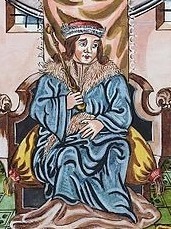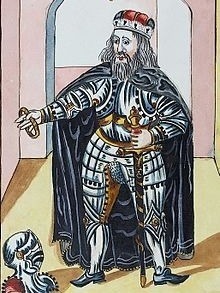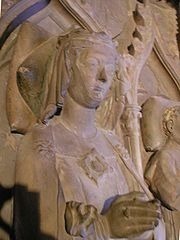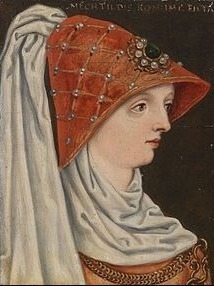Stamboom Snelder - Versteegh » Emperor Rudolf I of Germany (1218-1291)
Persoonlijke gegevens Emperor Rudolf I of Germany
Bronnen 1, 2- Hij is geboren op 1 mei 1218 in Schloss Limbourg, Freiburg, Baden-Wuerttemberg, Germany.
- Hij is overleden op 22 juli 1291 in Speyer, Pfalz, Bavaria, Allemagne, hij was toen 73 jaar oud.
- Hij is begraven in het jaar 1291 in Dom Speyer, Oberpfalz, Bavaria.
- Een kind van Albert IV of Habsburg en Hedwi of Kyburg
Gezin van Emperor Rudolf I of Germany
Hij had een relatie met Gertrude of Habsburg.
Kind(eren):
Notities over Emperor Rudolf I of Germany
https://en.wikipedia.org/wiki/Rudolf_I_of_Germany
Rudolf I, also known as Rudolf of Habsburg (German: Rudolf von Habsburg, Czech: Rudolf Habsburský; 1 May 1218 – 15 July 1291), was Count of Habsburg from about 1240 and the elected King of the Romans from 1273 until his death.
Rudolf's election marked the end of the Great Interregnum in the Holy Roman Empire after the death of the Hohenstaufen emperor Frederick II in 1250. Originally a Swabiancount, he was the first Habsburg to acquire the duchies of Austria and Styria in opposition to his mighty rival, the Přemyslid king Ottokar II of Bohemia, whom he defeated in the 1278 Battle on the Marchfeld. The territories remained under Habsburg rule for more than 600 years, forming the core of the Habsburg Monarchy and the present-day country of Austria.
Rudolf was the first king of the Romans of the Habsburg dynasty, and he played a vital role in raising the comital house to the rank of Imperial princes. He was also the first of a number of late medieval count-kings, so called by the historian Bernd Schneidmüller, from the rival noble houses of Habsburg, Luxembourg, and Wittelsbach, all striving after the Roman-German royal dignity, which ultimately was taken over by the Habsburgs in 1438.
Rudolf was born on 1 May 1218 at Limburgh Castle near Sasbach am Kaiserstuhl in the Breisgau region of present-day southwestern Germany.[1] He was the son of Count Albert IV of Habsburg and of Hedwig, daughter of Count Ulrich of Kyburg.[2] Around 1232, he was given as a squire to his uncle, Rudolf I, Count of Laufenburg, to train in knightly pursuits.
At his father's death in 1239, he inherited large estates from him around the ancestral seat of Habsburg Castle in the Aargau region of present-day Switzerland as well as in Alsace. Thus, in 1240[3] in order to quell the rising power of Rudolf and in an attempt to place the important "Devil’s Bridge" (Teufelsbrücke) across the Schöllenenschluchtunder his direct control, Emperor Frederick II, granted Schwyz Reichsfreiheit in the Freibrief von Faenza.
In 1242, Hugh of Tuffenstein provoked Count Rudolf through contumelious expressions.[clarification needed] In turn, the Count of Habsburg had invaded his domains, yet failed to take his seat of power. As the day passed on,[clarification needed] Count Rudolf bribed the sentinels of the city and gained entry, killing Hugh in the process. Then in 1244, to help control Lake Lucerne and restrict the neighboring forest communities of Uri, Schwyz and Unterwalden, Rudolf built near its shores Neuhabsburg Castle.[3] In 1245 Rudolf married Gertrude, daughter of Count Burkhard III of Hohenberg. He received as her dowry the castles of Oettingen, the valley of Weile, and other places in Alsace, and he became an important vassal in Swabia, the former Alemannic German stem duchy. That same year, Emperor Frederick II was excommunicated by Pope Innocent IVat the Council of Lyon. Rudolf sided against the Emperor, while the forest communities sided with Frederick. This gave them a pretext to attack and damage Neuhabsburg. Rudolf successfully defended it and drove them off. As a result, Rudolf, by siding with the Pope, gained more power and influence.[3]
Rudolf paid frequent visits to the court of his godfather, the Hohenstaufen emperor Frederick II, and his loyalty to Frederick and his son, King Conrad IV of Germany, was richly rewarded by grants of land. In 1254, he engaged with other nobles of the Staufen party against Bertold II, Bishop of Basle. When night fell, he penetrated the suburbs of Basle and burnt down the local nunnery. Pope Innocent IV excommunicated him and all parties involved. As penance, he took up the cross and joined Ottokar II, King of Bohemia in the Prussian Crusade of 1254. Whilst there, he oversaw the founding of the city of Königsberg, which was named in memory of King Ottokar.
The disorder in Germany during the interregnum after the fall of the Hohenstaufen dynasty afforded an opportunity for Count Rudolf to increase his possessions. His wife was a Hohenberg heiress; and on the death of his childless maternal uncle Count Hartmann IV of Kyburg in 1264, he also seized his valuable estates. Successful feuds with the Bishops of Strasbourg and Basel further augmented his wealth and reputation, including rights over various tracts of land that he purchased from abbots and others.
These various sources of wealth and influence rendered Rudolf the most powerful prince and noble in southwestern Germany (where the tribal Duchy of Swabia had disintegrated, enabling its vassals to become completely independent). In the autumn of 1273, the prince-electors met to choose a king after Richard of Cornwall had died in England in April 1272. Rudolf's election in Frankfurt on 1 October 1273,[4] when he was 55 years old, was largely due to the efforts of his brother-in-law, the Hohenzollern burgrave Frederick III of Nuremberg. The support of Duke Albert II of Saxony and Elector Palatine Louis II had been purchased by betrothing them to two of Rudolf's daughters.
As a result, within the electoral college, King Ottokar II of Bohemia (1230–1278), himself a candidate for the throne and related to the late Hohenstaufen king Philip of Swabia (being the son of the eldest surviving daughter), was almost alone in opposing Rudolf. Other candidates were Prince Siegfried I of Anhalt and Margrave Frederick I of Meissen (1257–1323), a young grandson of the excommunicated Emperor Frederick II, who did not yet even have a principality of his own as his father was still alive. By the admission of Duke Henry XIII of Lower Bavaria instead of the King of Bohemia as the seventh Elector,[5] Rudolf gained all seven votes.
Rudolf was crowned in Aachen Cathedral on 24 October 1273. To win the approbation of the Pope, Rudolf renounced all imperial rights in Rome, the papal territory, and Sicily, and promised to lead a new crusade. Pope Gregory X, despite the protests of Ottokar II of Bohemia, not only recognised Rudolf himself, but persuaded King Alfonso X of Castile(another grandson of Philip of Swabia), who had been chosen German (anti-)king in 1257 as the successor to Count William II of Holland, to do the same. Thus, Rudolf surpassed the two heirs of the Hohenstaufen dynasty whom he had earlier served so loyally.
In November 1274, the Imperial Diet at Nuremberg decided that all Crown estates seized since the death of the Emperor Frederick II must be restored, and that King Ottokar II must answer to the Diet for not recognising the new king. Ottokar refused to appear or to restore the duchies of Austria, Styria and Carinthia together with the March of Carniola, which he had claimed through his first wife, a Babenberg heiress, and which he had seized while disputing them with another Babenberg heir, Margrave Hermann VI of Baden. Rudolf refuted Ottokar's succession to the Babenberg patrimony, declaring that the provinces reverted to the Imperial crown due to the lack of male-line heirs. King Ottokar was placed under the imperial ban; and in June 1276 war was declared against him.
Having persuaded Ottokar's former ally Duke Henry XIII of Lower Bavaria to switch sides, Rudolf compelled the Bohemian king to cede the four provinces to the control of the royal administration in November 1276. Rudolf then re-invested Ottokar with the Kingdom of Bohemia, betrothed one of his daughters to Ottokar's son Wenceslaus II, and made a triumphal entry into Vienna. Ottokar, however, raised questions about the execution of the treaty, and procured the support of several German princes, again including Henry XIII of Lower Bavaria. To meet this coalition, Rudolf formed an alliance with King Ladislaus IV of Hungary and gave additional privileges to the Viennese citizens. On 26 August 1278, the rival armies met at the Battle on the Marchfeld, where Ottokar was defeated and killed. The March of Moravia was subdued and its government entrusted to Rudolf's representatives, leaving Ottokar's widow Kunigunda of Slavonia in control of only the province surrounding Prague, while the young Wenceslaus II was again betrothed to Rudolf's youngest daughter Judith.
Rudolf's attention next turned to the possessions in Austria and the adjacent provinces, which were taken into the royal domain. He spent several years establishing his authority there but found some difficulty in establishing his family as successors to the rule of those provinces. At length the hostility of the princes was overcome. In December 1282, at the Hoftag (imperial diet) in Augsburg, Rudolf invested his sons, Albert and Rudolf II, with the duchies of Austria and Styria and so laid the foundation of the House of Habsburg. Additionally, he made the twelve-year-old Rudolf Duke of Swabia, a merely titular dignity, as the duchy had been without an actual ruler since Conradin's execution.[citation needed]The 27-year-old Duke Albert, married since 1274 to a daughter of Count Meinhard II of Gorizia-Tyrol (1238–95), was capable enough to hold some sway in the new patrimony.
In 1286, King Rudolf fully invested Albert's father-in-law Count Meinhard with the Duchy of Carinthia, one of the conquered provinces taken from Ottokar. The Princes of the Empire did not allow Rudolf to give everything that was recovered to the royal domain to his own sons, and his allies needed their rewards too. Turning to the west, in 1281 he compelled Count Philip I of Savoy to cede some territory to him, then forced the citizens of Bern to pay the tribute that they had been refusing. In 1289 he marched against Count Philip's successor, Otto IV, compelling him to do homage.
In 1281, Rudolf's first wife died. On 5 February 1284, he married Isabella, daughter of Duke Hugh IV of Burgundy, the Empire's western neighbor in the Kingdom of France.
Rudolf was not very successful in restoring internal peace. Orders were indeed issued for the establishment of landpeaces[clarification needed] in Bavaria, Franconia and Swabia, and afterwards for the whole Empire. But the king lacked the power, resources, and determination to enforce them, although in December 1289 he led an expedition into Thuringia, where he destroyed a number of robber castles. In 1291, he attempted to secure the election of his son Albert as German king. The electors refused, however, claiming inability to support two kings, but in reality, perhaps, wary of the increasing power of the House of Habsburg. Upon Rudolf's death they elected Count Adolf of Nassau.
Rudolf died in Speyer on 15 July 1291 and was buried in Speyer Cathedral. Although he had a large family, he was survived by only one son, Albert, afterwards the German king Albert I. Most of his daughters outlived him, apart from Katharina who had died in 1282 during childbirth and Hedwig who had died in 1285/6.
Rudolf's reign is most memorable for his establishment of the House of Habsburg as a powerful dynasty in the southeastern part of the realm. In the other territories, the centuries-long decline of Imperial authority since the days of the Investiture Controversy continued, and the princes were largely left to their own devices.
In the Divine Comedy, Dante finds Rudolf sitting outside the gates of purgatory with his contemporaries and berates him as "he who neglected that which he ought to have done".[6]
Rudolf was married twice. First, in 1251, to Gertrude of Hohenberg[7] and second, in 1284, to Isabelle of Burgundy, daughter of Hugh IV, Duke of Burgundy.[7] All children were from the first marriage.).
- Matilda (c. 1253, Rheinfelden – 23 December 1304, Munich), married 1273 in Aachen to Louis II, Duke of Bavaria[8] and became mother of Rudolf I, Count Palatine of the Rhineand Louis IV, Holy Roman Emperor.
- Albert I of Germany (July 1255 – 1 May 1308), Duke of Austria and also of Styria.
- Catherine (1256 – 4 April 1282, Landshut), married 1279 in Vienna to Otto III, Duke of Bavaria[8] who later (after her death) became the disputed King Bela V of Hungary ;and left no surviving issue.
- Agnes [Gertrude] (ca. 1257 – 11 October 1322, Wittenberg), married 1273 to Albert II, Duke of Saxony[8] and became the mother of Rudolf I, Duke of Saxe-Wittenberg.
- Hedwig (c. 1259 – 26 January 1285/27 October 1286), married 1270 in Vienna to Otto VI, Margrave of Brandenburg-Salzwedel and left no issue.[8]
- Clementia (c. 1262 – after 7 February 1293), married 1281 in Vienna to Charles Martel of Anjou, the Papal claimant to the throne of Hungary[8]
- Hartmann (1263, Rheinfelden – 21 December 1281), drowned in Rheinau.
- Rudolf II, Duke of Austria and Styria (1270 – 10 May 1290, Prague), titular Duke of Swabia, father of John the Patricide of Austria.
- Judith of Habsburg (Jutte/Bona) (13 March 1271 – 18 June 1297, Prague), married 24 January 1285 to King Wenceslaus II of Bohemia and became the mother of king Wenceslaus III of Bohemia, Poland and Hungary, of queen Anne of Bohemia (1290–1313), duchess of Carinthia, and of queen Elisabeth of Bohemia (1292–1330), countess of Luxembourg.
- Samson (before 19 Oct 1275 – died young).
- Charles (14 February 1276 – 16 August 1276).
Rudolf's last legitimate agnatic descendant was Maria Theresa, Holy Roman Empress (1717–1780), by Albert I of Germany's fourth son Albert II, Duke of Austria.
Tijdbalk Emperor Rudolf I of Germany
 grootouders
grootouders
 ouders
ouders
 broers/zussen
broers/zussen
 kinderen
kinderen
Voorouders (en nakomelingen) van Rudolf I of Germany
Rudolf I of Germany 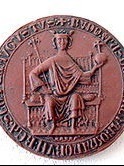 | ||||||||||||||||||||||||||||||||||
Gertrude of Habsburg | ||||||||||||||||||||||||||||||||||
Verwantschap Emperor Rudolf I of Germany
- Rudolf I of Germany is de achter(x51)kleinzoon van Titus Manlius Imperiosus Torquatus:Titus Manlius Imperiosus TorquatusTitus Manlius TorquatusTitus Manlius TorquatusAulus Manlius TorquatusTitus Manlius TorquatusDecimus Junius Silanus ManlianusMarcus Junius Silanus consulMarcus Junius SilanusMarcus Junius Silanus consulMarcus Junius SilanusJunia Calvina EquitusGaius SallustiusGaius Ummidius Quadratus SallustiusGaius Ummidius Quadratus Annianus VerusGaius Ummidius Quadratus Annianus Verus FulviusUmmidia Commificia AntoniaPendania Pedanius FuscusMariana MinorAurelia PompeianaClaudiaConstantius I Chlorus of RomeUnkownProcopius UsurperProcopiusProcopius II Magister Militum of ByzantiumProcopius Anthemius I of the of the Western Roman EmpireAlypia Princess of the of RomeCaratene Agrippina of NarbonneClothilde of BurgundyChlothar I of the FranksCharibert I of ParisBilichildeArnoald of MetzDodaAnsegisel of the FranksPepin II of HerstalCharles Martel of the FranksCarloman of the FranksRotrudeBeague l of ParisEngeltrude of ParisEberhard of FriuliUnruoch III of FriuliEberhard of SülichgauCunigunda of FranceFrederic I of Upper LorraineIta of MetzWerner I 'the Pious' of HabsburgOtto II ''der Gelehrte'' of HabsburgWerner II of HabsburgAlbert III of HabsburgRudolf II of HabsburgAlbert IV of HabsburgRudolf I of Germany
Bronnen
- WikiTree, via https://www.myheritage.nl/research/colle...
Rudolf I von HabsburgGeslacht: ManGeboorte: 1 mei 1218 - Schloss Limburg, RH, Freiburg, BadenHuwelijk: 6 feb 1284 - Bazel or Remiremont an der oberen MoselHuwelijk: 1245Overlijden: 15 jul 1291 - Speyer, Rheinland-PfalzVader: Albrecht IV Habsburg (geboren Hapsburg)Moeder: Heilwig Habsburg (geboren Kyburg)Echtgenote(n/s): Isabelle de Bourgogne (geboren Bourgondië), Dame de ChGertrud von HohenbergKinderen: Mathilde von HabsburgJutta Judith van Oostenrijk van Bohemia (geboren Habsburg)Rudolf Österreich (geboren Habsburg)Hedwig Sachsen (geboren Habsburg)Albrecht Österreich (geboren Habsburg)Clementia van Habsburg, van OostenAgnes Gertrud Österreich (geboren Habsburg)Catharina Österreich (geboren Habsburg)Euphemia Princess Of Habsburg (geboren Austria)Friedrich Prince Of Habsburg (geboren Austria)Hartmann Prince of HabsburgAdelaide Justina Adeladja Habsburg (geboren von Habsburg)Prinz Karl von Habsburg (geboren Habsburg)Foto's:
www.wikitree.com
- FamilySearch Stamboom, via https://www.myheritage.nl/research/colle...
Römisch-deutscher König Rudolf von Habsburg I.Namen geboorte: Rudolf IRudolf I Count Of Hapsburg King Of The GermansRudolf I of Austria HabsburgRudolf I van HabsburgRudolf I King Of The GermansRudolf I von HabsburgRudolf Ii King Of The GermansRudolf IV King of Germany Count of HabsburgRudolph I King of the GermansRudolph II Habsburg of Austria Duke of AustriaOok bekend als: Rudolf of HabsburgRudolf HabsburskýRudolf von HabsburgGeslacht: ManGeboorte: 1 mei 1218 - Schloss Limbourg, Freiburg, Baden-Wuerttemberg, GermanyHuwelijk: Echtgeno(o)t(e): Ita - Tussen 8 jan 1239 en 7 jan 1240 - <Schloss Limburg A.D. RH., Freiburg, Baden>Huwelijk: Echtgeno(o)t(e): Gertrude de Hohenberg - Tussen 8 jan 1245 en 7 feb 1245Huwelijk: Echtgeno(o)t(e): Agnes de Bourgogne - Tussen 8 jan 1284 en 7 jan 1285Huwelijk: Echtgeno(o)t(e): Agnes (Isabelle) Burgundy Princess of Burgundy - Tussen 8 jan 1284 en 7 jan 1285 - Burgund, SwitzerlandHuwelijk: Echtgeno(o)t(e): Isabella of Burgundy, Lady of Vieux-Château, Queen of Germany - 13 feb 1284Overlijden: 22 jul 1291 - Speyer, Pfalz, Bavaria, AllemagneBegrafenis: 1291 - Dom Speyer, Oberpfalz, BavariaEr schijnt een probleem te zijn met de verwanten van deze persoon. Bekijk deze persoon op FamilySearch om deze informatie te bekijken. Aanvullende informatie:
Lineage: House of Habsburg
Titel: Graf von Habsburg
TitleOfNobility: King of Germany
LifeSketch: Rudolf I, also known as Rudolf of Habsburg (German: Rudolf von Habsburg, Czech: Rudolf Habsburský; 1 May 1218 – 15 July 1291), was Count of Habsburg from about 1240 and the elected King of the Romans from 1273 until his death. King of Germany (formally King of the Romans) Reign 29 September 1273 – 15 July 1291 Coronation 24 October 1273 Aachen Cathedral Predecessor (Richard of Cornwall) Interregnum Successor Adolf of Nassau Duke of Carinthia Reign 1276 – 1 February 1286 Predecessor Ottokar II of Bohemia Successor Meinhard II of Gorizia-Tyrol Duke of Austria and Styria Reign 26 August 1278 – 27 December 1282 Predecessor Ottokar II of Bohemia Successor Albert I Born 1 May 1218 Limburgh Castle near Sasbach am Kaiserstuhl Died 15 July 1291 (aged 73) Speyer Burial Speyer Cathedral Spouse Gertrude of Hohenburg Isabella of Burgundy Issue more... Albert I of Germany Rudolf II, Duke of Austria Matilda, Duchess of Bavaria Catherine, Duchess of Bavaria Agnes, Duchess of Saxony Hedwig, Mangravine of Brandenburg Clementia, Queen of Hungary Judith, Queen of Bohemia House House of Habsburg Father Albert IV, Count of Habsburg Mother Hedwig of Kyburg Rudolf's election marked the end of the Great Interregnum in the Holy Roman Empire after the death of the Hohenstaufen emperor Frederick II in 1250. Originally a Swabian count, he was the first Habsburg to acquire the duchies of Austria and Styria in opposition to his mighty rival, the Přemyslid king Ottokar II of Bohemia, whom he defeated in the 1278 Battle on the Marchfeld. The territories remained under Habsburg rule for more than 600 years, forming the core of the Habsburg Monarchy and the present-day country of Austria. Rudolf was the first king of the Romans of the Habsburg dynasty, and he played a vital role in raising the comital house to the rank of Imperial princes. He was also the first of a number of late medieval count-kings, so called by the historian Bernd Schneidmüller, from the rival noble houses of Habsburg, Luxembourg, and Wittelsbach, all striving after the Roman-German royal dignity, which ultimately was taken over by the Habsburgs in 1438. Early life Rudolf's election marked the end of the Great Interregnum in the Holy Roman Empire after the death of the Hohenstaufen emperor Frederick II in 1250. Originally a Swabian count, he was the first Habsburg to acquire the duchies of Austria and Styria in opposition to his mighty rival, the Přemyslid king Ottokar II of Bohemia, whom he defeated in the 1278 Battle on the Marchfeld. The territories remained under Habsburg rule for more than 600 years, forming the core of the Habsburg Monarchy and the present-day country of Austria. Rudolf was the first king of the Romans of the Habsburg dynasty, and he played a vital role in raising the comital house to the rank of Imperial princes. He was also the first of a number of late medieval count-kings, so called by the historian Bernd Schneidmüller, from the rival noble houses of Habsburg, Luxembourg, and Wittelsbach, all striving after the Roman-German royal dignity, which ultimately was taken over by the Habsburgs in 1438. Early life Edit Rudolf was born on 1 May 1218 at Limburgh Castle near Sasbach am Kaiserstuhl in the Breisgau region of present-day southwestern Germany.[1] He was the son of Count Albert IV of Habsburg and of Hedwig, daughter of Count Ulrich of Kyburg.[2] Around 1232, he was given as a squire to his uncle, Rudolf I, Count of Laufenburg, to train in knightly pursuits. Count of Habsburg Edit At his father's death in 1239, he inherited large estates from him around the ancestral seat of Habsburg Castle in the Aargau region of present-day Switzerland as well as in Alsace. Thus, in 1240[3] in order to quell the rising power of Rudolf and in an attempt to place the important "Devil’s Bridge" (Teufelsbrücke) across the Schöllenenschlucht under his direct control, Emperor Frederick II, granted Schwyz Reichsfreiheit in the Freibrief von Faenza. In 1242, Hugh of Tuffenstein provoked Count Rudolf through contumelious expressions.[clarification needed] In turn, the Count of Habsburg had invaded his domains, yet failed to take his seat of power. As the day passed on,[clarification needed] Count Rudolf bribed the sentinels of the city and gained entry, killing Hugh in the process. Then in 1244, to help control Lake Lucerne and restrict the neighboring forest communities of Uri, Schwyz and Unterwalden, Rudolf built near its shores Neuhabsburg Castle.[3] In 1245 Rudolf married Gertrude, daughter of Count Burkhard III of Hohenberg. He received as her dowry the castles of Oettingen, the valley of Weile, and other places in Alsace, and he became an important vassal in Swabia, the former Alemannic German stem duchy. That same year, Emperor Frederick II was excommunicated by Pope Innocent IV at the Council of Lyon. Rudolf sided against the Emperor, while the forest communities sided with Frederick. This gave them a pretext to attack and damage Neuhabsburg. Rudolf successfully defended it and drove them off. As a result, Rudolf, by siding with the Pope, gained more power and influence.[3] Rudolf paid frequent visits to the court of his godfather, the Hohenstaufen emperor Frederick II, and his loyalty to Frederick and his son, King Conrad IV of Germany, was richly rewarded by grants of land. In 1254, he engaged with other nobles of the Staufen party against Bertold II, Bishop of Basle. When night fell, he penetrated the suburbs of Basle and burnt down the local nunnery. Pope Innocent IV excommunicated him and all parties involved. As penance, he took up the cross and joined Ottokar II, King of Bohemia in the Prussian Crusade of 1254. Whilst there, he oversaw the founding of the city of Königsberg, which was named in memory of King Ottokar. Rise to power Edit The disorder in Germany during the interregnum after the fall of the Hohenstaufen dynasty afforded an opportunity for Count Rudolf to increase his possessions. His wife was a Hohenberg heiress; and on the death of his childless maternal uncle Count Hartmann IV of Kyburg in 1264, he also seized his valuable estates. Successful feuds with the Bishops of Strasbourg and Basel further augmented his wealth and reputation, including rights over various tracts of land that he purchased from abbots and others. These various sources of wealth and influence rendered Rudolf the most powerful prince and noble in southwestern Germany (where the tribal Duchy of Swabia had disintegrated, enabling its vassals to become completely independent). In the autumn of 1273, the prince-electors met to choose a king after Richard of Cornwall had died in England in April 1272. Rudolf's election in Frankfurt on 1 October 1273,[4] when he was 55 years old, was largely due to the efforts of his brother-in-law, the Hohenzollern burgrave Frederick III of Nuremberg. The support of Duke Albert II of Saxony and Elector Palatine Louis II had been purchased by betrothing them to two of Rudolf's daughters. As a result, within the electoral college, King Ottokar II of Bohemia (1230–1278), himself a candidate for the throne and related to the late Hohenstaufen king Philip of Swabia (being the son of the eldest surviving daughter), was almost alone in opposing Rudolf. Other candidates were Prince Siegfried I of Anhalt and Margrave Frederick I of Meissen (1257–1323), a young grandson of the excommunicated Emperor Frederick II, who did not yet even have a principality of his own as his father was still alive. By the admission of Duke Henry XIII of Lower Bavaria instead of the King of Bohemia as the seventh Elector,[5] Rudolf gained all seven votes. King of the Germans Rudolf was crowned in Aachen Cathedral on 24 October 1273. To win the approbation of the Pope, Rudolf renounced all imperial rights in Rome, the papal territory, and Sicily, and promised to lead a new crusade. Pope Gregory X, despite the protests of Ottokar II of Bohemia, not only recognised Rudolf himself, but persuaded King Alfonso X of Castile (another grandson of Philip of Swabia), who had been chosen German (anti-)king in 1257 as the successor to Count William II of Holland, to do the same. Thus, Rudolf surpassed the two heirs of the Hohenstaufen dynasty whom he had earlier served so loyally. Rudolf was not very successful in restoring internal peace. Orders were indeed issued for the establishment of landpeaces[clarification needed] in Bavaria, Franconia and Swabia, and afterwards for the whole Empire. But the king lacked the power, resources, and determination to enforce them, although in December 1289 he led an expedition into Thuringia, where he destroyed a number of robber castles. In 1291, he attempted to secure the election of his son Albert as German king. The electors refused, however, claiming inability to support two kings, but in reality, perhaps, wary of the increasing power of the House of Habsburg. Upon Rudolf's death they elected Count Adolf of Nassau. Death Rudolf died in Speyer on 15 July 1291 and was buried in Speyer Cathedral. Although he had a large family, he was survived by only one son, Albert, afterwards the German king Albert I. Most of his daughters outlived him, apart from Katharina who had died in 1282 during childbirth and Hedwig who had died in 1285/6. Rudolf's reign is most memorable for his establishment of the House of Habsburg as a powerful dynasty in the southeastern part of the realm. In the other territories, the centuries-long decline of Imperial authority since the days of the Investiture Controversy continued, and the princes were largely left to their own devices. In the Divine Comedy, Dante finds Rudolf sitting outside the gates of purgatory with his contemporaries and berates him as "he who neglected that which he ought to have done".[6]De FamilySearch Stamboom wordt gepubliceerd door MyHeritage onder licentie van FamilySearch International, de grootste genealogische organisatie in de wereld. FamilySearch is een nonprofit organisatie die gespnsord wordt door The Church of Jesus Christ of Latter-day Saints (Mormon Church).
Historische gebeurtenissen
Geboortedag 1 mei 1218
- Graaf Willem I (Hollands Huis) was van 1203 tot 1222 vorst van Nederland (ook wel Graafschap Holland genoemd)
Dag van overlijden 22 juli 1291
- Graaf Floris V (Hollands Huis) was van 1256 tot 1296 vorst van Nederland (ook wel Graafschap Holland genoemd)
Dezelfde geboorte/sterftedag
- 1218 » Jan van Avesnes, graaf van Henegouwen († 1257)
- 1218 » Rudolf I († 1291)
- 1238 » Magnus VI van Noorwegen, koning van Noorwegen († 1280)
- 1533 » Catalina Tomàs, Spaans heilige († 1574)
- 1602 » William Lilly, Engels astroloog en occultist († 1681)
- 1735 » Jan Hendrik van Kinsbergen, Nederlands zeeofficier († 1819)
- 1461 » Karel VII van Frankrijk (58)
- 1640 » Hendrik Casimir I van Nassau-Dietz (28), Nederlands stadhouder en militair
- 1676 » Paus Clemens X (86)
- 1813 » George Shaw (61), Brits botanicus en zoöloog
- 1819 » Sebald Justinus Brugmans (56), Nederlands arts, botanicus en hoogleraar
- 1826 » Giuseppe Piazzi (80), Italiaans astronoom
Over de familienaam Of Germany
- Bekijk de informatie die Genealogie Online heeft over de familienaam Of Germany.
- Bekijk de informatie die Open Archieven heeft over Of Germany.
- Bekijk in het Wie (onder)zoekt wie? register wie de familienaam Of Germany (onder)zoekt.
Roel Snelder, "Stamboom Snelder - Versteegh", database, Genealogie Online (https://www.genealogieonline.nl/stamboom-snelder-versteegh/I506926.php : benaderd 27 april 2024), "Emperor Rudolf I of Germany (1218-1291)".
